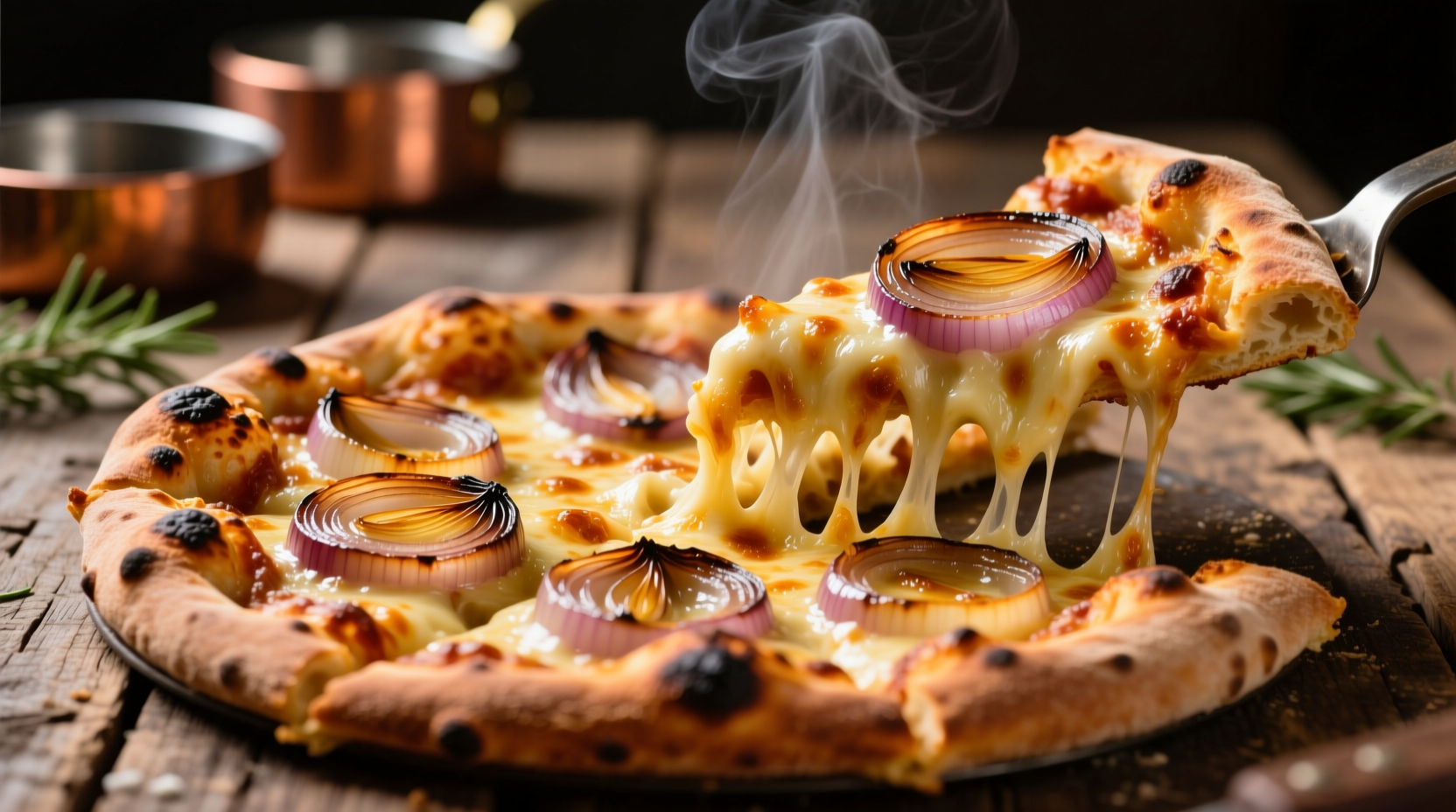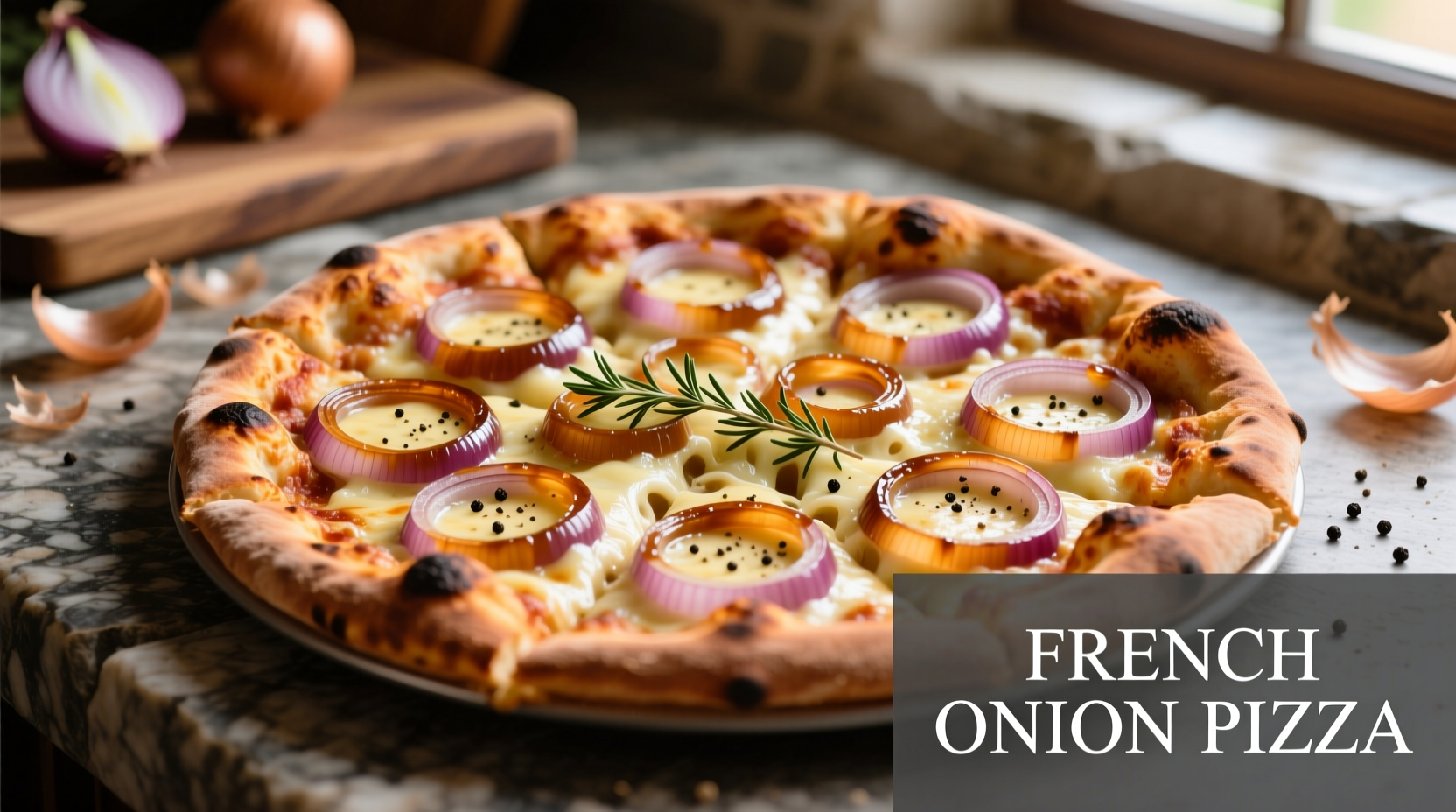French onion pizza combines the rich, savory flavors of traditional French onion soup with a crispy pizza base, creating a perfect balance of caramelized onions, melted Gruyère cheese, and savory broth-infused crust. This elevated comfort food requires proper onion caramelization, quality cheese selection, and strategic moisture control to prevent sogginess.
Transform your pizza night with this sophisticated yet approachable dish that bridges French culinary tradition and American comfort food. Whether you're hosting guests or craving something beyond ordinary pizza, mastering French onion pizza delivers restaurant-quality results at home with just six essential ingredients and careful attention to technique.
The Perfect Onion Selection and Caramelization Process
Not all onions work equally well for French onion pizza. Yellow onions provide the ideal balance of sweetness and pungency, while Vidalia or Walla Walla varieties offer milder sweetness perfect for those preferring less sharpness. The caramelization process transforms these humble bulbs through the Maillard reaction, developing complex flavor compounds that define this dish's character.
| Onion Type | Sweetness Level | Best For | Caramelization Time |
|---|---|---|---|
| Yellow Onions | Moderate | Traditional flavor profile | 40-45 minutes |
| Vidalia/Walla Walla | High | Milder, sweeter version | 35-40 minutes |
| Shallots | High | Delicate, nuanced flavor | 30-35 minutes |
According to research from the University of Minnesota Extension, proper caramelization requires low heat (around 300°F/150°C) and patience—rushing the process creates bitterness rather than the desired sweet, nutty complexity. Professional chefs typically use a 3:1 onion-to-fat ratio (butter or olive oil) to ensure even cooking without burning.
Building Your French Onion Pizza: Step-by-Step
The sequence of assembly makes or breaks your French onion pizza. Unlike traditional pizza, moisture management is critical when working with broth-infused toppings.
1. Prepare the Pizza Base
Use a slightly thicker crust than standard pizza to support the wetter toppings. Par-bake your dough for 3-4 minutes at 425°F (220°C) before adding toppings. This creates a moisture barrier that prevents sogginess—a technique validated by the American Pie Council's baking guidelines.
2. Onion and Broth Integration
After caramelizing your onions, reduce beef or vegetable broth by half in a separate pan, then combine with the onions. The ideal ratio is 1 cup reduced broth to 3 cups caramelized onions. This concentrated liquid adds flavor without excess moisture.
3. Cheese Layering Strategy
Apply a thin layer of grated Gruyère directly on the par-baked crust, followed by the onion mixture, then top with additional cheese. Food science research from University of Wisconsin Dairy Science shows that melting cheese creates a hydrophobic barrier that further protects the crust from moisture.

Avoiding Common French Onion Pizza Mistakes
Even experienced home cooks encounter pitfalls with this deceptively simple dish. Understanding these challenges prevents disappointment:
- Insufficient onion reduction—Wet onions create steam that softens the crust. Properly caramelized onions should have no visible liquid when pressed.
- Incorrect cheese selection—Avoid pre-shredded cheese with anti-caking agents that prevent proper melting. Freshly grated Gruyère or Comté provides superior texture.
- Overloading toppings—Use no more than 1½ cups of onion mixture per 12-inch pizza to maintain structural integrity.
- Inadequate resting time—Allow pizza to rest 5 minutes after baking for cheese to set and excess moisture to absorb.
Perfect Pairings and Serving Suggestions
Complement your French onion pizza with these thoughtful pairings that enhance its rich flavor profile:
- Wine—A medium-bodied red like Pinot Noir or dry French white like Chablis cuts through the richness
- Side salad—Bitter greens like arugula with lemon vinaigrette balance the sweetness
- Accompaniments—A small bowl of additional reduced broth for dipping elevates the experience
For optimal enjoyment, serve immediately after the resting period. Reheating requires special attention—use a skillet over medium-low heat rather than a microwave to maintain crust integrity.
Variations for Dietary Preferences
Adapt this classic recipe while preserving its essential character:
- Vegetarian version—Use high-quality mushroom or vegetable broth with a splash of soy sauce for umami depth
- Gluten-free option—Choose a sturdy gluten-free crust and increase par-baking time by 2 minutes
- Lower-sodium adaptation—Use low-sodium broth and enhance flavor with fresh thyme and a splash of sherry vinegar
- Dairy-free alternative—Combine nut-based cheeses with nutritional yeast for similar savory notes
Why French Onion Pizza Works: The Culinary Science
This fusion dish succeeds because it honors the fundamental principles of both French onion soup and pizza making. The slow caramelization develops 30+ flavor compounds identified in food chemistry research, while the pizza format provides textural contrast that traditional soup lacks. The crust's crispness against the melted cheese and tender onions creates a multisensory experience that explains its growing popularity among home cooks seeking elevated comfort food.











 浙公网安备
33010002000092号
浙公网安备
33010002000092号 浙B2-20120091-4
浙B2-20120091-4